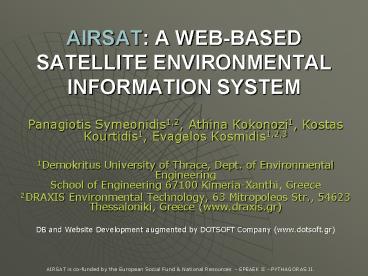AIRSAT: A WEBBASED SATELLITE ENVIRONMENTAL INFORMATION SYSTEM - PowerPoint PPT Presentation
1 / 21
Title:
AIRSAT: A WEBBASED SATELLITE ENVIRONMENTAL INFORMATION SYSTEM
Description:
AIRSAT: A WEB-BASED SATELLITE ENVIRONMENTAL INFORMATION SYSTEM ... DB and Website Development augmented by DOTSOFT Company (www.dotsoft.gr) ... – PowerPoint PPT presentation
Number of Views:55
Avg rating:3.0/5.0
Title: AIRSAT: A WEBBASED SATELLITE ENVIRONMENTAL INFORMATION SYSTEM
1
AIRSAT A WEB-BASED SATELLITE ENVIRONMENTAL
INFORMATION SYSTEM
- Panagiotis Symeonidis1,2, Athina Kokonozi1,
Kostas Kourtidis1, Evagelos Kosmidis1,2,3 - 1Demokritus University of Thrace, Dept. of
Environmental EngineeringSchool of Engineering
67100 Kimeria-Xanthi, Greece - 2DRAXIS Environmental Technology, 63 Mitropoleos
Str., 54623 Thessaloniki, Greece (www.draxis.gr) - DB and Website Development augmented by DOTSOFT
Company (www.dotsoft.gr)
AIRSAT is co-funded by the European Social Fund
National Resources - EPEAEK II - PYTHAGORAS II.
2
Introduction
- AIRSAT is an integrated, web-based satellite
environmental information system. - It provides to users environmental spatial
data about meteorological parameters
(temperature, humidity, pressure, wind speed,
precipitation), atmospheric variables (?3, ??2,
aerosols), and ocean geophysical
variables (chlorophyll, sea surface temperature).
- Further, it provides online tools for spatial
data analysis with focus on the atmospheric and
oceanic environment, using remote sensing data,
geographical information systems (GIS) and web
databases and interfaces. - The data that will be presented in AIRSAT are
freely available for public access in internet
and derive from various space agencies like ESA,
DLR and NASA.
3
The AIRSAT Modules
- Satellite Data (manual or automatic download
procedures) - Data Processing (Remote Sensing Format ? ESRI
ASCII grid format) - Image Generation Application (VB6 - ArcObjects)
- Database (SQL-SERVER)
- WEB Application (ASP)
4
Satellite data
5
Satellite data
6
Satellite data
7
Satellite data
8
Satellite data
9
Data processing
- Data files were opened with RSIs IDL programming
language. - The first task performed was georefencing which
produced a corresponding .hdr file which can be
used in ENVI directly. - The second task results to the production of
ascii files in ESRIs GRID format which will be
used later for the production of the remote
sensing images for the web application and for
populating the database.
10
Database design
- A database has been created in order to store and
query the data. The database was developed in
Microsoft, SQL Server 2000. - For the AIRSA? application the following tables
were used - Satellites
- Sensors
- Projections
- Acquisition
- Grid Areas
- Image data
- Grid Cells
- Remote sensing data
11
Image Generation Application
The application was developed using VB6 and
ArcObjects
- Basic GIS functionalities
- Special actions (create GRID, export images,
initialize / update database etc)
12
Application portal
- The basic functionalities of the web application
will include - Selection of remote sensing dataset. For single
users this will provide a short description and a
map (image) of the selected data. - A detailed description of the data will be
available to the advances users. They can
download / order data and maps from the download
area and share scientific content with each
other. - Area selection. There will be 2 different
geographical areas for data presentation. The
first is over Greece while the second covers the
whole Europe. - Data queries. Data querying will be available for
all users. The search criteria will be both
descriptive and geographic. - Data analysis. Data analysis will be performed
based on user interaction (interactive location
selection, time series selection, datasets
selection). The results will be graphs or tables.
Still Under Development !
13
Map Search (Selection of Grid, Date, Sensor)
- Select another date and acquire a new set of
images (In our example we picked sensor EP/TOMS,
both grids for it and dates from 16/11/2004 until
30/11/2004 - Choose more than one sensors for a specific date
14
Map Search (two dates)
- EP/TOMS results for two grids for dates from
16/11/2004 until 30/11/2004 - Click on the map and get the time series graph
for the according date interval.
15
Map Search (added functionality)
- Time series presentation
- Points derived from previous steps
- Download data of the chart in .csv format
16
Map Search (two sensors)
- Firstly, the results for GOME are shown
- Secondly, the results for EP/TOMS are shown
- Both on the same page
- Get the values for each sensor on the same point
17
Future Development and Plans
- Improvement of the Sites Usability
- Add Features
- User Management
- More Data Sets
- Sophisticated Tools for Data analysis (on-line)
- Correlation Analysis of the various parameters
selected by the user - 2-D graphics
18
IDEA (First Application) from
- UV-Network (www.uvnet.gr)
- The first and the ONLY network for UV data in
Greece (Satellite and Ground Based Data
combination). - Real Time Data Feed from 10 Stations (1 mobile)
- Scientific validations and
- Statistical Manipulation.
- Public Awareness and Information
- National Support from GSRT
19
UVNET Basic Map
20
Possible Conclusions (1)
- The AIRSAT project aims to provide
- A web portal with high resolution remote sensing
environmental data for the Thrace area and with
lower resolution for Europe. Those data, which
normally can be found in different sources, can
be used from local and international researchers
in other scientific studies. - The necessary infrastructure (data and knowledge)
for a comprehensive study of atmospheric
environment using new technologies like remote
sensing, GIS and web databases.
21
Possible Conclusions - Interests (2)
- We would like to have feedback or ideas on
- Possible projects based on the final product
Public Sector - Forest Fires Flood Management
- Application in new EC members.
- Environmental Decision Support Systems
Management - Incorporate innovative techniques.
- Apply BAPs (Best Available Practices)































